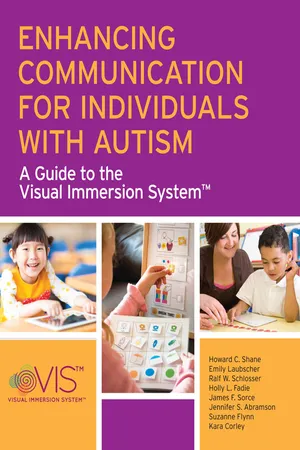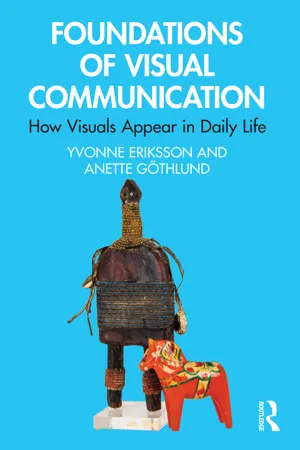Languages & Linguistics
Visual Description
Visual description refers to the use of language to create a mental image of a person, object, or scene. It involves the use of sensory details such as color, texture, and shape to help the reader or listener visualize what is being described. Visual description is often used in literature, poetry, and other forms of creative writing.
Written by Perlego with AI-assistance
Related key terms
Related key terms
1 of 4
Related key terms
1 of 3
4 Key excerpts on "Visual Description"
- eBook - ePub
Visual Communication
More than meets the eye
- Harry Jamieson(Author)
- 2006(Publication Date)
- Intellect Books(Publisher)
However while both types of communication , verbal and non-verbal, provide unique informational sources, they intertwine or cross fertilise each other. For example, as was mentioned earlier, images may cause specific words to be raised to consciousness; and conversely, words may cause images to be so raised. This is a well-known phenomenon, but whether the image can have a life as thought independent of verbal language has been open to question. For example, Barthes, on writing about semiology, went on to proclaim that “despite the spread of pictorial illustration, … it appears increasingly more difficult to conceive of images and objects whose signifieds exist independently of language”, and that “linguistics is not part of the general science of signs, even a privileged part, it is semiology which is part of linguistics”. From this verbo-centric standpoint, visual representations, which are part of the general family semiosis, exist in a hierarchy at the apex of which is linguistics.On the other hand, when we go beyond linguistics and into the realms of neural science, the separation that is apparent between word and image begins to disintegrate. Here (Damasio, 1992) we find that the term language is employed to describe interactive processes in the brain, especially those within and between the specialised areas or structures devoted to language and non-language. A hierarchy is not promulgated; the whole is seen as a machine which represents language as it represents any other entity.In discussing the wider issues that lie behind the concept of a visual language, which, correctly speaking, should be in parenthesis, we are constantly drawn to the part played by perception, to contextual figurations of a non-linear kind, and to styles and techniques of production and reproduction all of which contribute to the experience that we know as visual communication. It is these considerations that make the visual a more problematic arena for the construction of a grammar than we find in the verbal. And it is these factors with their surface level appeal to natural life, as opposed to the abstraction of the verbal, which complicates the task of formulating a language of vision. Whether it is possible to construct a coherent theory of visual communication with the same degree of certitude as that accorded to linguistics is open to speculation. Should we be able to do so, we would have gone some way to refute the scepticism of Gibson (1966) who said, “Although much has been written about language, there is no coherent theory of pictures.” And while our brief is wider than that of pictures, it has the same implications. - eBook - ePub
Handbook of Visual Communication
Theory, Methods, and Media
- Sheree Josephson, James Kelly, Ken Smith, Sheree Josephson, James Kelly, Ken Smith(Authors)
- 2020(Publication Date)
- Routledge(Publisher)
Because children developmentally cannot or do not pay attention to factual information in advertising—but rather to peripheral cues such as color and imagery—they tend to process advertising not through logical assessment but through their emotions (Barry, 1998). Thus, persuasion tends to be accomplished in both children and adolescents almost exclusively through imagery. Visual communication, visual thinking, and visual learning are inextricably linked to visual literacy (Seels, 1994). As we have noted above, these are among the main constructs comprising visual literacy theory and, consequently, their common thread running through the various VL definitions is usually straightforward to identify (Avgerinou, 2003). However, it is not always clear whether all three are concurrently present in any given definition. In engineering, science, and business, clear thinking is often synonymous with visual thinking. People can and do think visually. Horton (1991) noted that Albert Einstein and several other highly valued thinkers relied on visual images. Visualizing a message means an attempt to materialize it in an effective synthesis of pictures and words. In many cases, visuals may be the main source for information and communication today (Moore & Dwyer, 1994).Visual Language Must Be Learned
Visual literacy is a cognitive ability, but it also draws on the affective domain. In other words, VL involves cognitive functions such as critical viewing and thinking, imaging, visualizing, inferring as well as constructing meaning, communicating, as well as evoking feelings and attitudes (Avgerinou, 2001b).In visual language, meaning is apparent on a basic level, but visual language is a complex code that must be learned for true comprehension. We have to learn how to read visuals. It may take only two to three seconds to recognize the content in an image (Paivio, 1979; Postman, 1979). Yet, it takes 20–30 seconds to read a verbal description of the same image (Ekwall, 1977), and 60–90 seconds to read it aloud (Sinatra, 1986). In verbal and visual languages, prior experience and context are important to the perception of content.Comenius’ conclusion (Reynolds-Myers, 1985), that non-verbal communication between parent and child both precedes and forms the basis of later language acquisition and development, is still valid (Moriarty, 1994; Sinatra, 1986). Moriarty (1994) noted that “child development scholars would agree that visual communication skills are not secondary, derivative, impure or peripheral and, in fact, develop earlier than verbal skills in children” (p. 15). People who have not learned to read or write do not necessarily look at pictures in the intended order. It often proves helpful, as messages are being tested, to ask several groups of people to arrange the individual message into a sequence that seems most logical to them (Zimmermann & Perkin, 1982). - Howard C. Shane, Emily Laubscher, Ralf W. Schlosser, Holly L. Fadie, James F. Sorce, Jennifer S. Abramson, Suzanne Flynn, Kara Corley(Authors)
- 2015(Publication Date)
- Brookes Publishing(Publisher)
The ability to arrange graphics in a horizontal line does not necessarily indicate that the individual knows or is learning the linguistic relationship between the elements. For example, it is not unusual for a person with ASD to understand that a graphic depiction of a car in isolation stands for a car and a graphic splotch of blue represents the color blue. Simply lining up these two graphics next to each other, however, is inadequate for helping the person realize that BLUE and CAR should be interpreted as the single entity “blue car.” The all-important generative aspect of language is missing from such approaches. Such approaches make it easy to string graphic symbols together but do not explain or teach the linguistic rules for combining individual elements. This, in part, may explain the inherent lack of progress in evolving graphic symbol sets toward becoming visual languages. In contrast, the VIS provides a framework for teaching the linguistic skill of combining language constructs. Acquiring this ability gives the learner the capacity to generate semantic relationships using a set of established combinatorial rules, which is further explained in the next section. Rationale for Creating a Visual Language within the Visual Immersion System The VIS recognizes that comprehending or producing a series of graphic symbols that correspond to spoken or written language is a fundamental skill that needs to be developed before individuals can advance to using more highly developed means of augmented communication. The marvel of developing a visual language is that a series of isolated and inherently unrelated graphic symbols, each having its own designated or restricted meaning, can, when properly combined, represent an identifiable communicative operation such as a request, directive, comment, or question- eBook - ePub
Foundations of Visual Communication
How Visuals Appear in Daily Life
- Yvonne Eriksson, Anette Göthlund(Authors)
- 2023(Publication Date)
- Routledge(Publisher)
Our use of visual communication can be conscious or unconscious, and is more or less a part of a tradition or norm. Consider the clothing we wear, for instance. A uniform can communicate a specific profession (e.g., a police officer, pilot, or doctor), a bathing suit can signal that one is headed for the beach, and a formal suit may indicate that one is performing office work. The field of visual communication takes into account everything that is visible—amounting to a broad spectrum to investigate.Visual communication and representation
Regardless of whether the content is complex or not, all communication is an externalisation of our ‘inner voice’, our thoughts. The purpose of communication is to make such thoughts accessible to and understandable by someone else. Whether we wish to explain a concept, call attention to something, or entertain, communication is all about sharing with others. In fact, the etymology of communication is the Latin word communicare, which means to share, to make common. In order for this act of sharing to take place, there needs to be a common language—a cultural code, different kinds of signs—that has been agreed upon by the group of people partaking in it. It can be a cultural code that is agreed upon on a national level, or it can be one that is shared by a very small group or community. Some cultural codes are intended to include as many people as possible, while others are more exclusive in aim and are only shared with those who have been initiated.Apart from a common code system, every communicative act is dependent on a medium, whether it is text, speech or a visual. Visual communication, in all its aspects, can also be considered to enact what Nicholas Mirzoeff (1999) calls a visual event: ‘…an interaction of the visual sign, the technology that enables and sustains that sign, and the viewer.’ Mirzoeff also introduces the term visual technology, by which he means ‘any form of apparatus designed either to be looked at or to enhance natural vision, from oil painting to television and the Internet’ (1999 :13). Such technology, then, also functions as medium.Visual communication, or any communication for that matter, must be understood in terms of how it works as a system of representation. It is through the different languages we have access to that we create and exchange meaning, and produce and reproduce culture. We can only share and exchange meaning through a common language. The idea of a common language can be understood in different ways. It can refer to a common mother tongue or to a professional language which includes both verbal and visual representation. A common language can also consist of visual representations. For example, subcultures and global company cultures often develop and use a common visual language related to specific communication purposes to signal a common identity and ideals.
Index pages curate the most relevant extracts from our library of academic textbooks. They’ve been created using an in-house natural language model (NLM), each adding context and meaning to key research topics.
Explore more topic indexes
Explore more topic indexes
1 of 6
Explore more topic indexes
1 of 4



